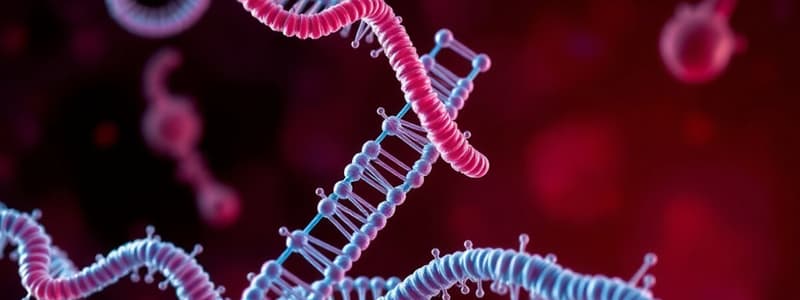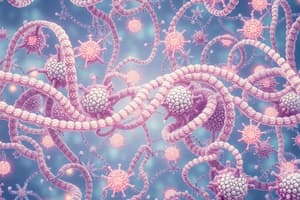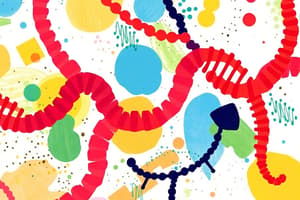Podcast
Questions and Answers
What role does a co-repressor play in the function of a repressor protein?
What role does a co-repressor play in the function of a repressor protein?
- It prevents the repressor from binding to the operator.
- It activates the repressor in the presence of the end product.
- It allows the repressor to bind to the operator site, decreasing gene expression. (correct)
- It stabilizes the mRNA produced by the operon.
What is the primary function of catabolic operons?
What is the primary function of catabolic operons?
- To synthesize compounds needed for cell function.
- To regulate the expression of regulatory proteins.
- To inhibit the activity of biosynthetic pathways.
- To degrade compounds in order to obtain catabolites for metabolism. (correct)
In the E.coli ara operon, what happens when arabinose is absent?
In the E.coli ara operon, what happens when arabinose is absent?
- AraC P2 activates transcription.
- AraC P1 binds to araI1 and araI2 to promote operon expression.
- AraC P1 functions as an anti-activator by binding to araO2 and araI1. (correct)
- AraC is unable to bind any sites, leading to increased transcription.
What does the term 'aporepressor' refer to?
What does the term 'aporepressor' refer to?
Which of the following statements describes negative regulation of operons?
Which of the following statements describes negative regulation of operons?
What distinguishes positive regulation in the context of operons from negative regulation?
What distinguishes positive regulation in the context of operons from negative regulation?
Which of the following accurately describes the function of AraC in the ara operon?
Which of the following accurately describes the function of AraC in the ara operon?
What is the primary purpose of biosynthetic operons?
What is the primary purpose of biosynthetic operons?
What is the effect on gene expression when a repressor is bound to the operator site?
What is the effect on gene expression when a repressor is bound to the operator site?
What is the primary role of repressors in transcriptional regulation?
What is the primary role of repressors in transcriptional regulation?
Which of the following statements about transcriptional regulators is true?
Which of the following statements about transcriptional regulators is true?
In a repressible system, how is gene expression typically controlled?
In a repressible system, how is gene expression typically controlled?
What defines a constitutive mutant?
What defines a constitutive mutant?
What is the function of an inducer in gene expression regulation?
What is the function of an inducer in gene expression regulation?
How do activators contribute to the process of transcription?
How do activators contribute to the process of transcription?
What mechanism does a repressor use to inhibit transcription initiation?
What mechanism does a repressor use to inhibit transcription initiation?
Which term describes the regulation of gene expression that occurs after the transcription process?
Which term describes the regulation of gene expression that occurs after the transcription process?
What is the role of co-repressors in gene regulation?
What is the role of co-repressors in gene regulation?
Which motif is mentioned as relevant for transcriptional regulation?
Which motif is mentioned as relevant for transcriptional regulation?
Flashcards
Gene Regulation
Gene Regulation
The process by which cells control which genes are expressed and at what levels.
Transcriptional Regulation
Transcriptional Regulation
Control of gene expression at the level of RNA synthesis, determining whether a gene is transcribed into mRNA.
Repressor
Repressor
A protein that binds to DNA and prevents the transcription of a gene.
Activator
Activator
Signup and view all the flashcards
Inducer
Inducer
Signup and view all the flashcards
Co-repressor
Co-repressor
Signup and view all the flashcards
Repressible System
Repressible System
Signup and view all the flashcards
Constitutive Mutant
Constitutive Mutant
Signup and view all the flashcards
Helix-Turn-Helix Motif
Helix-Turn-Helix Motif
Signup and view all the flashcards
Steric Hindrance
Steric Hindrance
Signup and view all the flashcards
How do repressors change DNA?
How do repressors change DNA?
Signup and view all the flashcards
Anti-activator
Anti-activator
Signup and view all the flashcards
Aaporepressor
Aaporepressor
Signup and view all the flashcards
Biosynthetic operon
Biosynthetic operon
Signup and view all the flashcards
Inducible system
Inducible system
Signup and view all the flashcards
Ara operon
Ara operon
Signup and view all the flashcards
Autoregulation
Autoregulation
Signup and view all the flashcards
Study Notes
Advanced Microbiology: Lecture 12 - Gene Expression Regulation
- Gene expression is controlled to ensure cells only express necessary genes in specific environments.
- Gene expression regulation occurs at various levels: transcriptional, post-transcriptional, translational, and post-translational.
- Most transcriptional regulation happens at the promoter region using proteins called transcriptional regulators.
- Repressors bind to DNA operator sequences, preventing transcription initiation (negative regulation).
- Activators are needed for RNA polymerase to initiate transcription.
- Inducers increase gene expression (by activating an activator or inactivating a repressor).
- Co-repressors decrease gene expression (by activating a repressor or inactivating an activator).
- Repressible systems regulate biosynthetic pathways based on end-product availability.
- Constitutive mutants always transcribe operon genes, regardless of inducer presence.
Transcriptional Regulation Details
- Regulators can be repressors, activators, or both.
- Regulation Mechanisms: negative, positive, or both.
- Activators: bind and recruit RNA polymerase; stabilize RNA polymerase binding to the promoter; promote open complex formation; promote frequency of initiation; can also inhibit repressors.
- Repressors: simplest mechanism is steric hindrance (preventing RNA polymerase binding or proceeding); can change DNA structure, inhibiting RNA polymerase binding or proceeding; can act as anti-activators, affecting activator positive activity.
Operon Regulation
- Catabolic operons degrade compounds for building molecules.
- Biosynthetic operons synthesize molecules like amino acids, nucleotides, and vitamins.
- Negative regulation: genes are usually on (constitutive) unless a repressor turns them off. Co-repressors bind to repressors, enabling binding to the operator, thus reducing expression.
- A repressor needing a co-repressor to be active is called an aporepressor.
Positive Regulation (E. coli ara Operon)
- Operon expression depends on an activator protein presence.
- The ara operon encodes enzymes for arabinose utilization.
- AraC is a divergently encoded transcriptional activator protein with dual function.
- In the presence of arabinose, AraC changes conformation (P2 binding), activates the operon by binding to AraO2 and other operator sequences.
- The absence of arabinose causes AraC to bind to different DNA sequences (P1) preventing transcription.
- AraC has autoregulation, high concentrations prevent transcription of the operon from P1.
DNA-Binding Protein Motifs
- Helix-turn-helix (HTH) motif is a common DNA-binding motif in proteins.
- These proteins typically consist of two alpha-helices and a linker connecting them.
- Amino acids in the recognition helix (helix 2) can interact and form hydrogen bonds with DNA bases in the major groove.
Studying That Suits You
Use AI to generate personalized quizzes and flashcards to suit your learning preferences.




